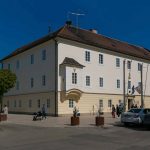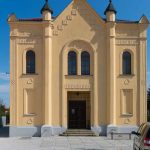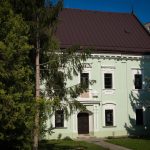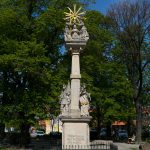THE REFORMED CHURCH BUILDING
Of all the historical buildings in Šamorín, the building of the Reformed Church is the most valuable. It is considered one of the oldest and most beautiful gothic churches in the Rye Island Region. It was originally built in the third quarter of the 13th century in late-Romanesque style. The original building was made up of the nave and the sanctum, without the vestry and aisles. It is likely that the church also served as a local fortress, where the aisles and tower, built later, enabled the early observation of approaching enemies, fires or floods. The church originally I had a beamed ceiling, but after the building of the south aisle in the 14th century, the ceiling was refurbished with a Gothic look. Sometime after 1449, the late Gothic ceiling was divided by octagonal pillars. On a tapestry-type picture, Mary is lying on her death bed, surrounded by the Apostles. Above this picture, her funeral and ascension to the heavens are shown on the arch. The last picture of the series, located in the triangle facing the nave, shows
the crowning of Mary. The central location of this picture series is evidence that the church was built to honour the Virgin Mary.
THE ROMAN CATHOLIC CHURCH AND MONASTERY
The church and the monastery were built according to the plans of J.G. Altenburg between 1722 and 1778. Both the church and the monastery, built by the Minims, are significant monuments of the late-Baroque style. The church has one nave and a sanctum with a segmented arch. Interior walls and ceiling are adorned with paintings
and murals; they depict the life and times of St. Francis of Paola. The Minims lived the ascetic life of a begging order. In Šamorín they were only able to sustain their monastery and church-building mission and liturgical and educational activities for a few decades before Joseph II dismissed the order in 1786. Thereafter, the abandoned
church became the property of the local Catholic congregation and the town. The monastery is now called “Korona” by locals, a name originating from the Korona restaurant which operated there in the side-wing owned by the town, until the 1960’s.
THE EVANGELICAL CHURCH
This church was built according to the plan of the architect Altenburg in 1784-1785. The church itself was built in Classicist style; however, interior furnishings also display Baroque elements. The single-manual organ, the work of Josef Effinger, was rebuilt into its current form by the organ-maker master Volgerthon in 1824. The picture of the
altar shows Christ’s resurrection and the tomb guards. It was painted in 1785 by the Lower Austrian painter Oelenhain. In the last decades of the 19th century, Slovak families sent their children to Šamorín to learn Hungarian and German. This was the case for the famous Slovak statesman. diplomat and scientist Milan Rastislav Stefanik, who as child became a student at the Evangelical school in Šamorín in 1889-90. His relief statue is located in front of the Evangelical vicarage.
THE SYNAGOGUE
The synagogue was built in 1912. The Jewish congregation used not only Romantic architectural features in its construction, but also motifs from the Middle East. The windows of the synagogue were decorated by coloured glass. The upper gallery, the area designated for women, divides the interior into two storeys. Following the Holocaust, the synagogue was practically unused for decades; since 1996, however, thanks to the At Home Gallery, it has served as a centre for contemporary art.
THE TOWN HALL
The Renaissance-style building was rebuilt several times. In the 17th and 18th centuries, the noblemen of Rye Island often met within its walls; a few times even the representatives of Bratislava County held their sessions here. The coffered ceiling is a valuable part of the former









